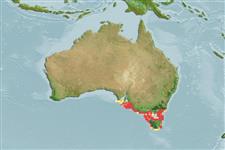分类 / Names
俗名 | 同种异名 | Catalog of Fishes(属, 种) | ITIS | CoL | WoRMS | Cloffa
Petromyzonti >
Petromyzontiformes (Lampreys) >
Mordaciidae (Southern topeyed lampreys)
Etymology: Mordacia: Etymology not explained, likely derived from mordax (L.), biting, referring to specific name of M. mordax. (See ETYFish); mordax: Latin for biting, perhaps referring to its parasitic behavior and/or serrated, cutting teeth. (See ETYFish).
More on author: Richardson.
Environment: milieu / climate zone / depth range / distribution range
生态学
海洋; 淡水; 半咸淡水 居于水底的; 溯河洄游 (Ref. 89241). 亞熱帶的; 35°S - 44°S (Ref. 26213)
Southern Ocean: Southeastern Australia from Shoalhaven River, New South Wales to Gulf of St. Vincent, South Australia.
南極海: 來自 Shoalhaven 河的澳洲東南部, 到聖文森,澳洲南部的灣的新南威爾斯。
大小 / 重量 / 年龄
Maturity: Lm ? range ? - ? cm
Max length : 50.0 cm TL 雄鱼/尚未辨别雌雄; (Ref. 5259); common length : 37.5 cm TL 雄鱼/尚未辨别雌雄; (Ref. 5259)
简单描述
型态特徵 | 形态测量图
Adults: 11.3-43.2 cm TL; body proportions of pre-spawning specimens, as percentage of TL (based on 125 prespawning specimens measuring 11.3-42.1 cm TL): 8.5-11.3 prebranchial length, 7.1-9.8 branchial length, 60.4-68.3 trunk length, 14.4-20.1 tail length, 1.1-1.7 eye length and 4.9-6.6 disc length. Body proportions of spawning male specimens, as percentage of TL (based on 8 spawning males measuring 27.7-37.6 cm TL): 11.4-16.6 prebranchial length, 8.8-10.1 branchial length, 60.1-65.3 trunk length, 13.3-15.7 tail length, 8.1-11.2 disc length. Mature males with some loose skin in gular region. Urogenital papilla not prominent in mature adults; trunk myomeres, 84-96. Adult dentition: 2 triangular supraoral laminae each with 3 unicuspid teeth, 1 per apex; infraoral lamina, 7-9 unicuspid teeth of various size (these teeth become greatly enlarged with sexual maturation); 5-7 endolateral plates on either side each bearing 2-3 unicuspid teeth, usually 3; endolateral formula, typically 2-3-3-3-3-3 in immature individuals and 5-7 individual cusps on either side in mature individuals; 1 row of anterials; first row of anterials, 2 unicuspid teeth plus 1-2 bicuspid teeth or 3 unicuspid teeth flanked on either side by 1 bicuspid tooth; 1 row of exolaterals on each side; 1 row of posterials; first row of posterials, 12-14 posterial plates, the 2-4 lateralmost tricuspid and the internal ones bicuspid in immature individuals and 12-14 unicuspid teeth in mature individuals; transverse lingual lamina w-shaped, with 29 unicuspid teeth, the median one and the 2 subterminal ones slightly enlarged; longitudinal lingual laminae interrupted j-shaped, each with an undetermined number of unicuspid teeth. Velar tentacles in adults, 3-4, smooth. Body coloration (live) of immature adults brownish gray on dorsal surface and silvery on ventral surface; lateral line neuromasts darkly pigmented; caudal fin pigmentation, 25% to <75% coverage; caudal fin shape, spade-like; oral papillae, 25-45 (Ref. 89241).
Adults inhabit the sea for an undetermined period and are parasitic on fishes; enter freshwater to breed. Majority of adulthood is spent in estuaries or at sea. Upstream spawning migrants occur in fast-flowing sections of rivers with a mud, sand or silt substrate, sometimes seen congregated below barriers to upstream movement such as weirs. Ammocoetes live in slow-flowing streams, burrowed in mud or silt. Common length is 35-40 cm (Ref. 44894). Larval life is 3.5 yrs. During the spawning migration, adults burrow in the substrate of rivers during the day and migrate upstream during the night. Fecundity, 3,789-13,372 eggs/female. De Castelnau (1872) states that the adults from the lower Yarra River, Victoria, are considered good food (Ref. 89241).
成鱼栖息于海洋一个未确定的时期而且是寄生在鱼上; 进入淡水到繁殖。 成人期的多数被在河口或在海上花费。 向上游产卵移居者出现在河川流速快的河段具有一个泥,沙子或淤泥底部, 有时见到在对向上游的运动例如鱼梁的障碍之下聚集。 Ammocoetes 生活于缓慢流动的溪流,被泥中掘穴的或淤泥。 普遍的长度是 35-40 公分。 (参考文献 44894)
Life cycle and mating behavior
成熟度 | 繁殖 | 产卵场 | 卵 | 孕卵数 | 仔鱼
南極海: 來自 Shoalhaven 河的澳洲東南部, 到聖文森,澳洲南部的灣的新南威爾斯。
Allen, G.R., 1989. Freshwater fishes of Australia. T.F.H. Publications, Inc., Neptune City, New Jersey. (Ref. 5259)
人类利用
更多信息
参考文献养殖养殖信息品种遗传学Electrophoreses遗传率疾病加工NutrientsMass conversion
合作者照片Stamps, Coins Misc.声音神经毒速度泳型鳃区Otoliths脑重体重比眼睛色素
工具
特别资料
下载 XML
网络资源
Estimates based on models
Preferred temperature (Ref.
123201): 14.3 - 16.8, mean 15.4 °C (based on 44 cells).
Phylogenetic diversity index (Ref.
82804): PD
50 = 0.7500 [Uniqueness, from 0.5 = low to 2.0 = high].
Bayesian length-weight: a=0.00102 (0.00046 - 0.00225), b=3.06 (2.88 - 3.24), in cm total length, based on all LWR estimates for this body shape (Ref.
93245).
营养阶层 (Ref.
69278): 4.3 ±0.8 se; based on size and trophs of closest relatives
回复力 (Ref.
120179): 低的, 最小族群倍增时间4.5 - 14 年 (Semelparous species, assuming tm (= tmax) > 4).
Fishing Vulnerability (Ref.
59153): Moderate vulnerability (40 of 100).
